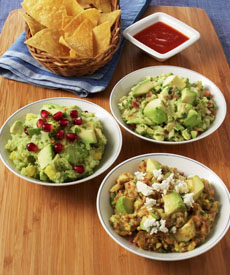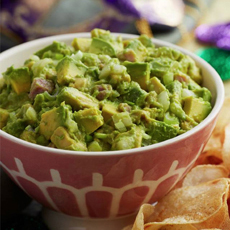TIP OF THE DAY: Serve A Guacamole Trio
 [1] Serve three different guacamole “flavors” at once (photo © Avocados From Mexico).
|
So many guacamole recipes, so little time! The solution: Make guacamole trios, three different recipes at a time. Here are some favorites of ours: You can also go for the Do-It-Yourself option: a Guacamole Party Bar. With the mashed avocado, lime juice and salt, provide some of the following: There are 21 pages of guacamole recipes on the website, including a Cranberry Guacamole recipe for the holidays. Mesoamericans cultivated the wild avocado, a tree fruit that had grown in the region for millions of years. Dating back to Mayan times (pre-Aztec), guacamole was made from avocado, onion, chiles, fresh tomato, and salt, a recipe that is still made today. The conquering Aztecs called the avocado ahuacatl. The “tl” is pronounced “tay” in Nahuatl, the Aztec language, hence, ah-hwa-CAH-tay. AhuacamOlli (ah-waka-MOLE-ee) is a compound of ahuacatl [avocado] + mOlli [sauce]. The chocolate-based mole sauce comes from that same word, mOlli. When the Spanish conquistadors under Hernán Cortés arrived in 1519, they heard ah-hwah-cah-tay as “aguacate,” the spelling and pronunciation they used. In Spanish, ahuacamOlli became guacamole (huac-ah-MOE-lay). Guacamole ingredients were mashed in a molcajete (mol-cah-HET-tay), a Mexican pestle carved from volcanic stone (today granite is an easier-to-clean option). Over time, different regions of Mexico mixed in local ingredients, creating countless variations. Ahuacatl, avocado, first meant “testicle” in Nahuatl. The Aztecs saw the avocado hanging from the tree branches as resembling testicles, and ate them as a sex stimulant. According to Linda Stradley on the website WhatsCookingInAmerica.com, for centuries after Europeans came into contact with the avocado, it carried its reputation for inducing sexual prowess. It wasn’t purchased or consumed by any genteel person concerned with his or her reputation. American avocado growers had to sponsor a public relations campaign to dispel the myth before avocados could become popular. After then, their dark green, pebbly flesh also earned avocados the polite name, “alligator pear.” |
|
|
|
||



